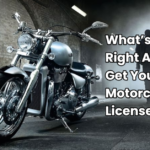introduction
Are you dreaming of the open road and the freedom that comes with riding your motorcycle? Before you hit the highway, one essential step remains: obtaining your motorcycle license. A motorcycle license is more than just paper. It certifies that you have the skills and knowledge needed to ride safely on public roads.
In this guide, we’ll walk you through the entire process of obtaining a motorcycle license in a straightforward and detailed manner. We’ll cover:

What Is a Motorcycle License?
A motorcycle license is an official document from your local government or transport authority, such as the DMV.. It shows that you have passed the necessary tests and training to ride a motorcycle. safely. Think of it as both a legal permit and a certification of your riding skills and knowledge.
Key Points:
Certification of Skills: It proves that you can handle the motorcycle controls and understand road safety.
Legal Requirement: Riding a motorcycle without a proper license is illegal and can result in fines or penalties.
Different Categories: Many areas offer various motorcycle licenses. These depend on engine size and the rider’s experience.
Read more:
Why You Need a Motorcycle License?
There are several reasons why obtaining a motorcycle license is crucial:
Legal Compliance: Riding without a licence can lead to serious legal issues. These include fines, impounding your motorcycle, or even jail time in extreme cases.
Safety: Getting a licence involves classroom instruction and practical training.
Insurance Benefits: Many insurers offer lower premiums to riders who complete safety courses and hold a valid motorcycle licence. licence.license.
Confidence: Training and testing in a structured way boosts your confidence, which helps you become a better and safer rider.
Access to Roads: Having a motorcycle licence lets you ride on public roads legally. This shows law enforcement that you are a skilled and responsible rider.
Step-by-Step Guide: How to Get a Motorcycle License
Getting your motorcycle license can feel overwhelming. However, if you break it down into simple steps, it becomes easier to grasp. Here’s a step-by-step overview:
1. Check the Requirements
Before you begin the application process, it’s essential to know what your local DMV or transportation authority requires. Requirements may include:
Age Restrictions: Typically, you must be at least 16 or 18 years old.
Residency Proof: You may need to provide documents that prove you live in your state or country.
Identification: A valid photo ID, such as a driver’s license or passport.
Written Materials: Study materials or a motorcycle operator’s manual available on the DMV website.
Tip: Check your local DMV’s website. Search for “motorcycle license requirements” to find the latest and most accurate info.
2. Obtain a Learner’s Permit
A learner’s permit is usually the first official step toward obtaining a full motorcycle license. It allows you to practice riding under specific restrictions.
Steps to Obtain a Learner’s Permit:
Fill Out an Application: Provide your personal information, including name, address, and date of birth.
Pass a Written Test: This test covers traffic laws, motorcycle controls, and safe riding practices.
Provide Identification and Payment: Submit your ID and pay any necessary fees.
Pass a Vision Test: A simple vision test ensures you have the eyesight needed to ride safely.
After you pass these tests, you’ll get a learner’s permit. This permit allows you to practice riding on public roads. Usually, you’ll need a licensed rider with you, or you can ride at certain times and places.
3. Enroll in a Motorcycle Safety Course
While not always mandatory, taking a motorcycle safety course is highly recommended. These courses are designed to teach you:
Basic Riding Techniques: Starting, stopping, turning, and shifting gears.
Defensive Riding: How to anticipate hazards and ride defensively.
Emergency Maneuvers: Techniques for sudden braking, swerving, and handling unexpected obstacles.
Benefits of a Safety Course:
Improved Skills: Gain practical riding skills under the guidance of experienced instructors.
Certificate of Completion: Some states require proof of completion to progress to a full license.
Insurance Discounts: Many insurers offer discounts to riders who complete certified safety courses.
Practice Riding
Practice is crucial for building your riding skills and confidence. Follow these steps to make the most out of your practice sessions:
Wear Proper Gear: Always wear a helmet, gloves, riding jacket, and boots.
Choose a Safe Location: Start in an empty parking lot or a quiet residential street.
Start Slowly: Begin with basic maneuvers such as starting, stopping, and turning.
Progress Gradually: When you feel more confident, try advanced skills. Focus on counter-steering and emergency braking.
Practice Under Supervision: If possible, ride with a licensed rider who can give you feedback.
Take the Road Test
After you’ve practiced sufficiently and met all the prerequisites, the next step is the road test. This test assesses your ability to operate a motorcycle safely under real-world conditions.
How to Prepare for the Road Test:
Schedule Your Test: Contact your DMV to schedule the test and confirm the documents you need to bring.
Review the Operator’s Manual: Go over the manual to refresh your memory on traffic laws and safe riding practices.
Practice Specific Maneuvers: Focus on skills that you know will be tested, such as:
Starting and stopping
Turning at different speeds
Emergency braking
Obstacle avoidance
Stay Calm and Confident: On the day of the test, arrive early, bring all required documents, and take deep breaths to stay relaxed.
If you pass the road test, you will be issued your full motorcycle license!
Final Steps: Obtain Your Motorcycle License
Once you pass the road test, the final steps typically include:
- Submit Documentation: Provide proof of training, passed tests, and any other required documents.
- Pay the Licensing Fee: You will usually need to pay a fee for your final license.
Get Your License: You might get a temporary license right away, while the permanent one will come by mail later, depending on where you live.
Congratulations! You are now legally permitted to ride a motorcycle on public roads. Remember, obtaining your license is just the beginning. Always ride responsibly, follow traffic laws, and continue to hone your riding skills.
Eligibility Requirements for a Motorcycle License
Eligibility criteria can vary based on where you live, but here are some common requirements:
1. Age
Minimum Age: In many places, you must be at least 16 or 18 years old.
Junior Licenses: Some regions offer provisional licenses for younger riders with additional restrictions.
2. Knowledge and Written Test
Traffic Laws: You must demonstrate a good understanding of local traffic laws and motorcycle safety.
Motorcycle Controls: Know the basics of how a motorcycle operates.
3. Vision Test
Eyewear: A vision test ensures you meet the minimum eyesight standards. If you wear glasses or contacts, you must bring them to the test.
4. Learner’s Permit
Before you take the full road test, you usually need to have a learner’s permit for a set time.practicing.
5. Motorcycle Safety Course
Optional vs. Mandatory: Some areas need you to finish a safety course before the road test, while others strongly suggest it.
6. Background Checks
Criminal Record: In some states or countries, a criminal record might affect your eligibility for a motorcycle license.
Check your local DMV or government website for these requirements. Rules can vary a lot by location.
Cost Considerations
The cost of obtaining a motorcycle license varies widely depending on several factors. Here’s a breakdown of potential expenses:
1. Licensing Fees
Application Fee: This fee covers the processing of your application.
Permit Fee: There is often a separate fee for the learner’s permit.
Road Test Fee: Some states charge a fee for scheduling and taking the road test.
2. Motorcycle Safety Course
Course Cost: Depending on your location, a safety course can cost anywhere from a few hundred to over a thousand dollars.
Materials: Some courses include fees for training materials and certification.
3. Safety Gear
Essential Equipment: A good helmet, gloves, jacket, and boots are safety must-haves. They also protect you, making them a wise investment.
Cost Range: Quality gear can range from a few hundred to several hundred dollars, but it is essential for your safety.
4. Study Materials
Manuals and Guides: Some states offer free manuals online, while others might charge a nominal fee for printed copies.
Overall, the total cost of obtaining your motorcycle license can range from a few hundred dollars to over a thousand dollars. However, think of this as an investment in your safety and the freedom to ride legally.
Motorcycle License in the USA: State-Specific Guidelines
If you’re in the United States, the process and requirements for obtaining a motorcycle license can vary by state. Here’s a quick overview of the process in a few states:
Maryland
Safety Course/Skills Test: Complete an MVA-approved motorcycle safety course or pass a skills test.
Written and Vision Tests: Pass both tests to obtain your learner’s permit.
Practice Period: Hold the learner’s permit (often for about 9 months) before taking the road test.
Road Test: Pass the road test to get your full license.
Virginia
Rider Training: Complete a Virginia Rider Training Program course or pass a skills test.
Permit Requirements: Pass a vision test and a knowledge test to obtain the learner’s permit.
Practice Time: You must practice riding with your permit before scheduling the road test.
Road Test: Successfully complete the road test to receive your license.
New Jersey
Safety Education: Take the New Jersey Motorcycle Safety Education Program course or pass a skills test.
Written Exam: Pass the knowledge test to secure your motorcycle permit.
Practice Requirement: Practice riding for at least 20 days before the road test.
Final Test: Pass the road test and earn your full motorcycle license.
California
Safety Program: Enroll in the California Motorcyclist Safety Program course or take a skills test.
Permit Process: Pass the written and vision tests to obtain your motorcycle learner’s permit.
Practice Period: A mandatory practice period (usually 6 months) is required.
Road Test: Complete the road test to receive your full license.
Basic Rider Course: Complete a Basic Rider Course or pass a skills test.
Testing: Pass both the vision and written tests to obtain your learner’s permit.
Practice Requirement: Practice riding for at least 20 days on your permit.
Final Step: Pass the road test and get your motorcycle license.
Note: Always check your state’s DMV website for the most current and specific requirements as these guidelines may change.
Tips and Best Practices for Beginners
Getting your motorcycle license is only the beginning of your riding journey. Here are some additional tips to ensure you stay safe and continue to improve:
1. Stay Educated
Review the Manual: Even after you’ve obtained your license, regularly review your state’s motorcycle operator manual.
Advanced Courses: Consider taking advanced riding courses to further enhance your skills.
2. Maintain Your Motorcycle
Regular Maintenance: Stick to the manufacturer’s maintenance schedule. This keeps your motorcycle running smoothly.
Safety Checks: Before every ride, check your tires, brakes, lights, and fluid levels.
3. Practice Defensive Riding
Stay Alert: Always be aware of your surroundings and anticipate the actions of other drivers.
Safe Distance: Keep a safe following distance to allow ample time to react.
Visibility: Wear bright clothing and use reflective gear to increase your visibility on the road.
4. Ride with the Weather
Weather Conditions: Stay off your motorcycle in severe weather until you feel confident riding in tough conditions.
Adjust Your Speed: Adapt your speed to road conditions—riding in rain or fog requires slower speeds and increased caution.
5. Join a Community
Rider Groups: Consider joining local or online motorcycle clubs. Sharing tips and experiences with other riders can be invaluable.
Mentorship: Riding with experienced riders can build your confidence. They offer practical tips that you may not get in a formal class.
6. Protect Yourself
Gear is Essential: Never compromise on safety gear. A quality helmet, protective clothing, and gloves are essential.
Insurance: Make sure you have the right coverage for your motorcycle and riding activities.
By following these tips, you can enjoy the thrill of riding while minimizing risks and staying safe on the road.
Frequently Asked Questions (FAQ)
Q1: What is a motorcycle license, and why do I need one?
A motorcycle license is an official document that certifies you have the necessary skills and knowledge to operate a motorcycle. It is legally required to ride on public roads and ensures that you have been tested for both safety and competence.
Q2: How do I start the process of getting a motorcycle license?
The process generally begins by checking your local requirements, obtaining a learner’s permit (which involves passing a written and vision test), and then enrolling in a motorcycle safety course. After practicing and passing a road test, you can obtain your full motorcycle license.
Q3: What age do I need to be to apply for a motorcycle license?
A: Most states require you to be at least 16 or 18 years old. Specific age requirements vary, so it’s best to check with your local DMV.
Q4: Is it necessary to take a motorcycle safety course?
A: While some states make it mandatory, many strongly recommend it for all beginners. These courses help you learn safe riding techniques, boost your confidence, and may even lower your insurance premiums.
Q5: How much does it cost to get a motorcycle license?
A: The cost can vary widely depending on your location. You may incur fees for the learner’s permit, the road test, safety courses, and necessary safety gear. Expect the
Conclusion
When your car won’t start, it can be incredibly frustrating, especially when you rely on it daily. As we’ve explored in this guide, there are 16 common reasons—ranging from a dead battery and faulty starter to fuel delivery issues and extreme weather conditions—that can prevent your vehicle from starting. Understanding these causes not only helps you diagnose the problem but also empowers you to take the appropriate steps, whether that means simple maintenance, DIY fixes, or seeking help from a professional mechanic.





